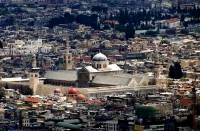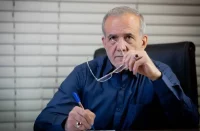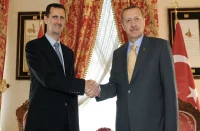The West sees Iran as a real threat. That perception is driving development of a missile defense system in Europe and the Middle East; ever tougher, so-called “crippling” economic and financial sanctions against Iran; support for both the internal opposition, which is not currently having a major impact on the country’s politics, and the various national minorities in their quest for independence; an information war; and a number of other actions that are destabilizing the situation not just in Iran but in all surrounding states, as well. How great is the nuclear and missile threat from that country? Let’s take a detailed look at it.
This winter, the International Atomic Energy Agency (IAEA) asked twice to visit the Parchin military base. It had good reason for doing so. According to intelligence from a number of countries, a neutron detonator — an initiator for a nuclear explosion — was tested at that base. That kind of activity can only be part of a nuclear weapons program. It is difficult to judge the validity of that intelligence. However, we can say that to build a nuclear device there must must first be enough weapons-grade fissionable material: in this case, highly enriched uranium, because Iran’s plutonium program is not sufficiently advanced. Therefore, the IAEA inspectors need to focus on a different facility — the Fordo uranium enrichment plant. The secret construction of that facility became known in September 2009. It is well protected from air attack because it is located inside a mountain. The Fordo plant can accommodate 3000 gas centrifuges for enriching uranium.

Currently, 700 gas centrifuges in the Fordo facility are engaged in enriching uranium-235 from 3.5% to 20%. That was previously done using just two centrifuge cascades (328 centrifuges) at the Natanz uranium enrichment pilot plant. And only low-capacity first-generation gas centrifuges were used (the P-1; Iranian designation — IR-1). Increasing the number and, possibly, changing the type of centrifuge enabled a 3-fold increase in the amount of 20% enriched uranium produced. By February, they had managed to obtain 110 kg of such nuclear material. But that is not enough to produce (after enriching to 90%) even one nuclear device. According to London’s International Institute for Strategic Studies, at least 172 kg are needed to make one device.
The increase in the number of gas centrifuge cascades from 37 to 52 at the Natanz uranium enrichment plant gave some cause for concern. If we assume that one cascade has 164 centrifuges, 8528 gas centrifuges are now engaged in enriching natural uranium to 3.5% (an increase of 2460 centrifuges since November 2011). By November 1 of last year, Iran had accumulated 4922 kg of low-enriched uranium (LEU) with a concentration of 3.5%, (some of which was later enriched to 20%). If the same production rate was maintained until February 1, 2012, 447 kg of LEU could have been produced, for a total of 5369 kg. Actually, the rate was higher, so we can assume that 5500 kg of uranium enriched to 3.5% had been produced by that time. After further enrichment to weapons grade, that would be enough to make five nuclear devices (983 kg of LEU enriched to 3.5% are needed to make one). These calculations require quite a bit of adjustment because, for example, double the fissionable material would be used for the first nuclear device. Nevertheless, it is obvious that a threshold is being approached (it is desirable to have at least five nuclear devices before the first nuclear test).
Therefore, the IAEA should closely monitor the Fordo nuclear facility (that is already being done for Natanz). The maximum enrichment level attained is the primary interest. A further increase in the uranium enrichment level with would be an indirect indicator of a nuclear weapons program. Iran’s leaders can justify enriching uranium to 60% for some research tasks. However, there is no need for a large amount of nuclear material enriched to that level. Also of interest are the type of gas centrifuges used and the configuration of their cascades. That information is not vital, but it would allow us to determine the time needed for uranium enrichment should the decision be made to build a nuclear weapon.
By and large, the situation with Iran’s nuclear program is not critical at present. Tehran may continue making progress towards developing a closed nuclear fuel cycle without crossing the “red line”, i.e., conducting a nuclear test. Preventing it from doing so is the main task of the international community. Unfortunately, the West’s explicitly hostile stance towards Iran, its own regional ambitions and somewhat inflated estimates of the country’s military capabilities (which apparently are not limited to Iranian experts), the extremely low accuracy of Iran’s short- and medium-range ballistic missiles, and a number of other factors will push Tehran to go nuclear. As a minimum, that could lead to missile and bomb strikes on Iranian territory by Israel.
The international community is greatly concerned by Iran’s steady accumulation of fissionable material. It only has low-enriched uranium for now (Iran is not currently producing highly enriched uranium, that is, uranium enriched to a concentration of more than 20% U-235), but the quantity it has is already causing concern because it lacks a peaceful purpose. The situation would change fundamentally if Russian specialists were to build a facility in Iran to produce fuel for the Bushehr nuclear power plant. After the fuel is certified, it could be used in the existing power reactor, following which the spent nuclear fuel would be taken to Russia in accordance with the existing Russian-Iranian agreement. The quantity of Iranian nuclear fuel would then not be important (a 1-GW reactor requires 20 tons of fuel enriched to less than 5%), since Ukraine has already confirmed that nuclear fuel from different manufacturers can be used in a reactor simultaneously. That is actually one of the few a peaceful solutions to the Iranian nuclear problem.
We should address Iran’s missile program separately. It has resulted in the fielding of the Shehab-3, Shahab-3M and Qadr-1 single-stage, medium-range ballistic missiles. The Qadr-1 has the longest range: 1600 km with a 750-kilogram reentry vehicle (it can carry a 500 kg warhead). Considering that these missiles are located in the center of the country, they clearly pose no missile threat to Israel (the distance from Yazd to Tel Aviv is 1848 km). Of course, a lighter reentry vehicle would increase the range. But that would make it extremely difficult to mount a nuclear warhead because, according to the experts, a nuclear warhead based on weapons-grade uranium suitable for use on a booster rocket would weigh 415-868 kg and have a diameter of 600-650 mm.
Iran currently has no more than 32 launchers for the brigade-level, single-stage, liquid-fueled Shehab-3 and Qadr-1. The circular error probable (CEP) of these missiles is 2.0-2.5 km. That makes it extremely difficult to use them against mobile targets, but it does not prevent their mass use against oil tankers in the Persian Gulf, as one example. Should the political decision be made, however, a more realistic application would be against large ground military and civilian targets in the Middle East.
Iran is currently using only mobile platforms for its ballistic missiles. According to Western reports, however, launch silos have been built near Tabriz and Khorramabad, possibly because Iran has a limited number of mobile launchers. The West believes that Iran has a total of six launchers for its Shehab-3 and Qadr-1 missiles (from 4 to 17 per launcher). Those launchers are upgraded versions of imported trailers. That number for the mobile launchers is probably low.
Tehran had planned to develop the Shahab-5 and Shahab-6 ballistic missiles having ranges of 3000 and 5000-6000 km, respectively (the program to develop the Shahab-4 with a range of 2200-3000 km was canceled or suspended in October 2003 for political reasons). According to Russian and American experts, however, the potential for developing missiles of that type has largely been exhausted. Of course, that would not prevent the Iranians from developing multi-stage, liquid-fueled missiles, but it is more likely that most of their resources will be focused on improving their solid-fuel missiles (the technologies for developing liquid-fueled rockets are mainly applicable to space).
Iran is currently developing the two-stage, solid-fuel Sajjil-2, which was flight-tested in May 2009. The range of this missile with a 1-tonne warhead is 2200 km. Use of a 500 kg warhead would increase the range to 3000 km (in which case it would be unable to carry a nuclear warhead, as noted earlier). This type of missile does not require fueling before launch. It also has a shorter boost phase, which makes it difficult to intercept during the most vulnerable part of its trajectory. The Sajjil-2 could become operational in 2013.
Thus, Iran currently does not present a missile or nuclear threat, even for Israel. Of course, the development of that capability is of concern to the international community. But the situation has not yet reached the critical stage where the use of force against Iran becomes unavoidable.
Vladimir Evseev is the Director of the Russian Center for Social and Political Studies.
Source: New Eastern Outlook














The more it becomes obvious that Iran poses no real short-term threat to both USA and Israel, the frenzy for war must be,as a matter of fact, a smoke curtain hiding a major, grand plan directed to Russia and China, Iran being just the scapegoat or the excuse ad hoc. Precisely as in the current case of Syria, in which Iran is indeed the political telos.
But as Syrian regime did not fall – on the contrary – and Iran is showing defying signs of a prolonged endurance, plans are not exactly going according to schedules and that could mean a precipitated twist for the worse. Again, Lorentz`s Chaos theory may play a role here.